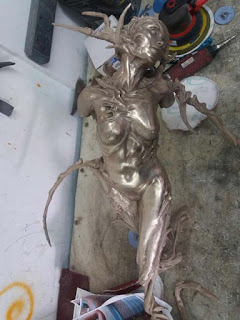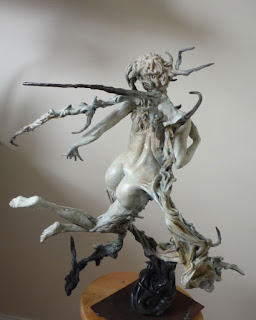"It's a limited edition it's not unique, once it is made they can keep on casting them".
Is something I often hear people say when they are looking at a bronze sculpture
The inference is that another can be "knocked" out on a whimsy, this often leads them to ask
"can you tell us how it is actually made"?
With my own very limited knowledge I then try to explain what has been described to me.
But I confess that even though I have visited foundries and spoken with many sculptors
my own understanding of the process is basic at the very least.
So when a few months ago the sculptor Scott Shaw told me that he would cast a sculpture
the gallery I asked if it was possible for him to send me photographs of the work in progress.
I had no idea of what to expect I just wanted to feel involvement with the sculpture
Before it eventually arrived here.
Over a period of many weeks Scott sent me regular updates, images and descriptions of what
he was doing and how it was done.
I was staggered.
I really had had no idea of the scale of his task.
From the hundreds of photographs I received I have compiled a series which I hope
will give an idea of the work, skill and dedication involved to make this wonderful piece of art
RIBBONS OF BONE
From the plaster mold taken from the original sculpture wax castings were made
Later these would then be used to create a ceramic "shell" into which the bronze would
be poured
The complex nature of the sculpture meant many pieces were molded, some in sections
which were then joined and modeled again
Constant thought of how and where the bronze would flow and how the shells would hold together
meant that channels were created to join various sections to guide the bronze
to the right places
A cup is created which when melted will act as a funnel
The waxes receive their first coating of shell
Zircon mined from volcanoes is used to make a slurry for the coating
Before then being dusted with molochite
Eight coats in total, one a day
The completed shells need then to be "burnt out" to remove
the wax.
[unfortunately that image is out of sequence and is 5 below]
This leaves hollow shells which are then kiln fired to harden them further
The hardened shells being buried upside down with the funnels at the top which are covered to protect the inside from contamination
This is the "mistake" out of sequence image of the wax being burnt from the shell molds
Molten bronze being poured into the empty shells
After eventually cooling the fun starts as the shells are smashed apart
to reveal the hardened bronze
Once removed they are cleaned and then sand blasted
Before the long delicate process of welding the many pieces together, the joins ground down,
detail restored before sanding down
Seven stages of sanding by hand
Each with a finer grade to give the fine smooth tactile surface that we associate with bronze
Joined, polished but still far from complete
Unfortunately bronze is still associated with a brown coloring
But that really is now a thing of the past, the finish or patination is limited only by the imagination and the experience of the artist.
Creating the patina is a skill in its own right
Many foundries employ someone just for this, and many sculptors may choose a foundry
just because of that persons ability.
Fortunately Scott Shaw has the ability to create, cast and patinate.
Here are his photographs of the nearly completed piece as he works his magic
Finishing the sculpture as his mind conceived it
Finished?
Almost, just a marble base to cut
Here it is again.
Just a quick sculpture he knocked out.
I think that now I am perhaps more confused now than before about the whole making process.
But I do know that I will never look at a bronze sculpture in the same way ever again
Especially this one
I will have to return to this with more detailed images and Scott's own story about his creation.
As I have been writing I have had to pause many times to admire and touch the sculpture.
It really is a work of art.





























